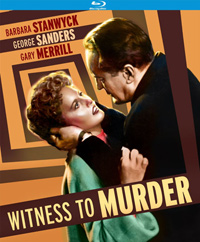 Available for the first time on Blu-ray or DVD and remastered in high definition is forgotten film noir Witness to Murder, a 1954 Barbara Stanwyck potboiler also starring George Sanders and Gary Merrill. As written by Chester Erskine (The Egg and I, 1947), the film feels like plenty of other narratives, though its frustrating contrivance of hysteria as dramatic tension places it squarely within a particular male dominated paradigm. In particular, the film feels eerily reminiscent of Alfred Hitchcock’s Rear Window, which actually opened a month after this Roy Rowland directed venture, doomed to be overshadowed and quickly forgotten. But, magnificently photographed by John Alton, it’s a shadowy and angular motion picture, enjoyable for its considerable melodrama as a portrait of misinformed and misogynistic gender politics.
Available for the first time on Blu-ray or DVD and remastered in high definition is forgotten film noir Witness to Murder, a 1954 Barbara Stanwyck potboiler also starring George Sanders and Gary Merrill. As written by Chester Erskine (The Egg and I, 1947), the film feels like plenty of other narratives, though its frustrating contrivance of hysteria as dramatic tension places it squarely within a particular male dominated paradigm. In particular, the film feels eerily reminiscent of Alfred Hitchcock’s Rear Window, which actually opened a month after this Roy Rowland directed venture, doomed to be overshadowed and quickly forgotten. But, magnificently photographed by John Alton, it’s a shadowy and angular motion picture, enjoyable for its considerable melodrama as a portrait of misinformed and misogynistic gender politics.
Cheryl Draper (Barbara Stanwyck) witnesses a young woman being murdered in the apartment complex adjacent to her own. She calls the police to report what she sees. Before the police can arrive, we witness the murderer, Albert Richter (George Sanders) hide the body. The police inspect his apartment, but lead Detective Lawrence Mathews (Gary Merrill) can’t seem to find anything awry and explains that a neighbor lady across the way called in the complaint. But Cheryl is sure of what she saw, leading her to conduct her own snooping, which forces Richter, a celebrated author, to frame Cheryl so that she looks as if she’s going insane. Luckily, Detective Mathews has taken a fancy to her.
In truth, it’s quite difficult to watch the strong willed Stanwyck play such a passively hopeless dame, a woman who remains iconic for one of the most icy femme fatales in film noir history in Billy Wilder’s Double Indemnity (1947). Likewise, the inclusion of Juanita Moore, credited as a “Negress mental patient” is a stifling reminder of uncomfortably awkward racial discrimination of the period, even as this stands as the film’s most striking (and sweaty) sequences. Referred to as a ‘girl’ by her romantic counterpart, played rather unenthusiastically by Gary Merrill (married, at one time, to Bette Davis), Stanwyck was in the latter stages of her leading lady status, styled in way that makes her reminiscent of a petite Bea Arthur. George Sanders seems to enjoy chewing his scenery, an actor who often enlivened subpar offerings when allowed to be the villain (such as Robert Siodmak’s 1945 film The Strange Affair of Uncle Harry).
Disc Review
Remastered in high definition, damage and severe grain are often evident in Kino Lorber’s presentation of Witness to Murder. Alton’s playful use of shadows and windows makes for some delectable imagery amidst all the dated plot contrivances. Considering the scare availability of the title previous to this release, it’s a respectable presentation of an overlooked film, though bereft of any special features.
Final Thoughts
A strange precursor to Rear Window, and, therefore, equally reminiscent of the set-up of Brian De Palma’s Sisters (1973), Witness to Murder isn’t incredibly adept as a logical film noir, hanging all dramatic tension on gender politics of the period, by which even a murderer could turn the tables on a material witness by casting her sanity into doubt. The film’s treatment of Stanwyck’s Cheryl Draper as a woman prone to hysteria, powerful nightmares, and lacking in self-esteem is hardly righted by the swiftly turning tables leading to the logical and predictable finale, which still necessitates the help of a smug love interest forced to save his lady love from a throng of bystanders shouting that ‘some crazy dame is trying to kill herself.’ As compared to even other films that famously starred Stanwyck as a woman who sees or hears too much, such as the more notable Sorry, Wrong Number (1948), Witness is most remarkable for its evocative set designs and pleasurable noir cinematography.
Film: 3/5
Disc: 3.5/5


